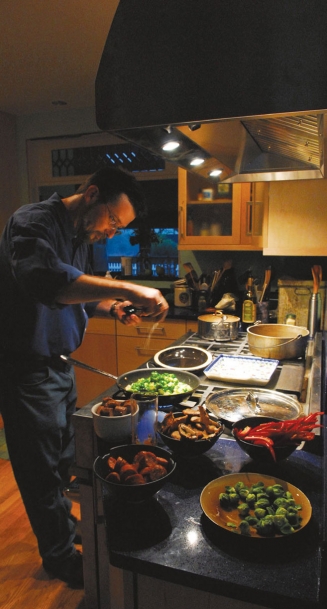The Substantial Health Benefits of Eating at Home
The only downside to cooking at home is doing the dishes. In fact, the benefits of home-cooking are not only substantial, they are substantiated.
The research on this isn’t simply anecdotal. People who frequently cook meals at home eat healthier food and consume fewer calories than those who cook less. Researchers have also found that those who cook at home rely less on frozen foods and are less likely to choose fast foods on the occasions when they do eat out. Good habits lead to more good habits when it comes to dietary choices.
The good effects of eating at home extend to health patterns not having anything to do with food, per se. Teens who eat meals at home with their families are less likely to use and abuse alcohol, cigarettes and drugs, leading to better mental and physical health and better grades at school.
The average American eats out four to five times per week. Though most of us seek to eat a healthier diet, the ramifications of sub-par food can begin to accumulate if you consume over 18 commercially prepared meals a month. Whether it’s at a restaurant, a food truck or the food court at the mall, even if we try to make “healthy choices” the fact is once our order is placed, we really have no control over the food. Sodium in copious amounts, refined sweeteners and “bad” fats (trans, hydrogenated, reused and rancid) are all unhealthy and may be invisible ingredients in the food that ends up on our plate. Eating meals outside of the home also leads to more food intake: 50% more calories on average, and more fat and sodium in general. For those of you who are squirming here, takeout and home delivery count as eating out.
It isn’t only about what we eat, it’s how we eat it, too. People who eat at home, and specifically, families that eat together, have been found to consume a more nutrient-rich diet. In fact, the mere action of sitting and eating meals in a calm setting encourages better portion control, digestion and nutrient absorption. Eating fast food is the worst case scenario, not surprisingly, because it induces faster eating, more food intake in a shorter period of time and increased bite morsel size. These actions are detrimental for both digestion and nutrient absorption. The body wants to eat food slowly. When your mom told you to take small bites and chew your food, she was right! Food that is chewed more thoroughly (up to 40 times!) is more fully absorbed and utilized by the body. This is because smaller pieces make nutrients more bioavailable. Large food particles, those that are only chewed 10 to 25 times, are often expelled from the body, undigested.
Many of the health challenges and diseases that plague us today are a result of the Standard American Diet, a consequence of what we eat, as opposed to the simple process of aging. These illnesses include obesity, coronary heart disease, hypertension, type 2 diabetes and certain cancers. Your best bet is to embrace foods that enrich your health, rather than those that rob you of it.
Eating at home lets us choose where we buy our provisions, how we prepare and season our food and the very act of how we consume our meals. If we relinquish these decisions to another source on a regular basis, we give up control over our very well-being.
Choose from a diet abundant in:
• Seasonal fruits and vegetables, making certain they are pesticideand GMO-free, and organic whenever possible
• A variety of minimally processed whole grains
• Heart-healthy fats
• Hormone- and antibiotic-free dairy and pastured meats
• Fish and seafood from sustainable, unsullied sources
• Antioxidant-rich herbs and spices
• and, most importantly, cook your own food
With just a bit of forethought, meals away from home can be prepared beforehand and brown-bagged. Hard-boiled eggs, plain yogurt with fresh fruit and nuts, or oatmeal are all easily transportable breakfast options, packing a nutritional punch while saving you from the processed fare of the American marketplace. Whole-grain breads with any variety of nut butters, salads with healthy protein choices, leftover grains or pasta with vegetables prepared at home are all fantastic packed-lunch options. The alternatives are endless. Start a new healthy habit, and make it stick.
The real path to optimum health is to buy your own food and cook it at home. Those dishes that you’ll have to do? Let them soak. You’ve earned it.




